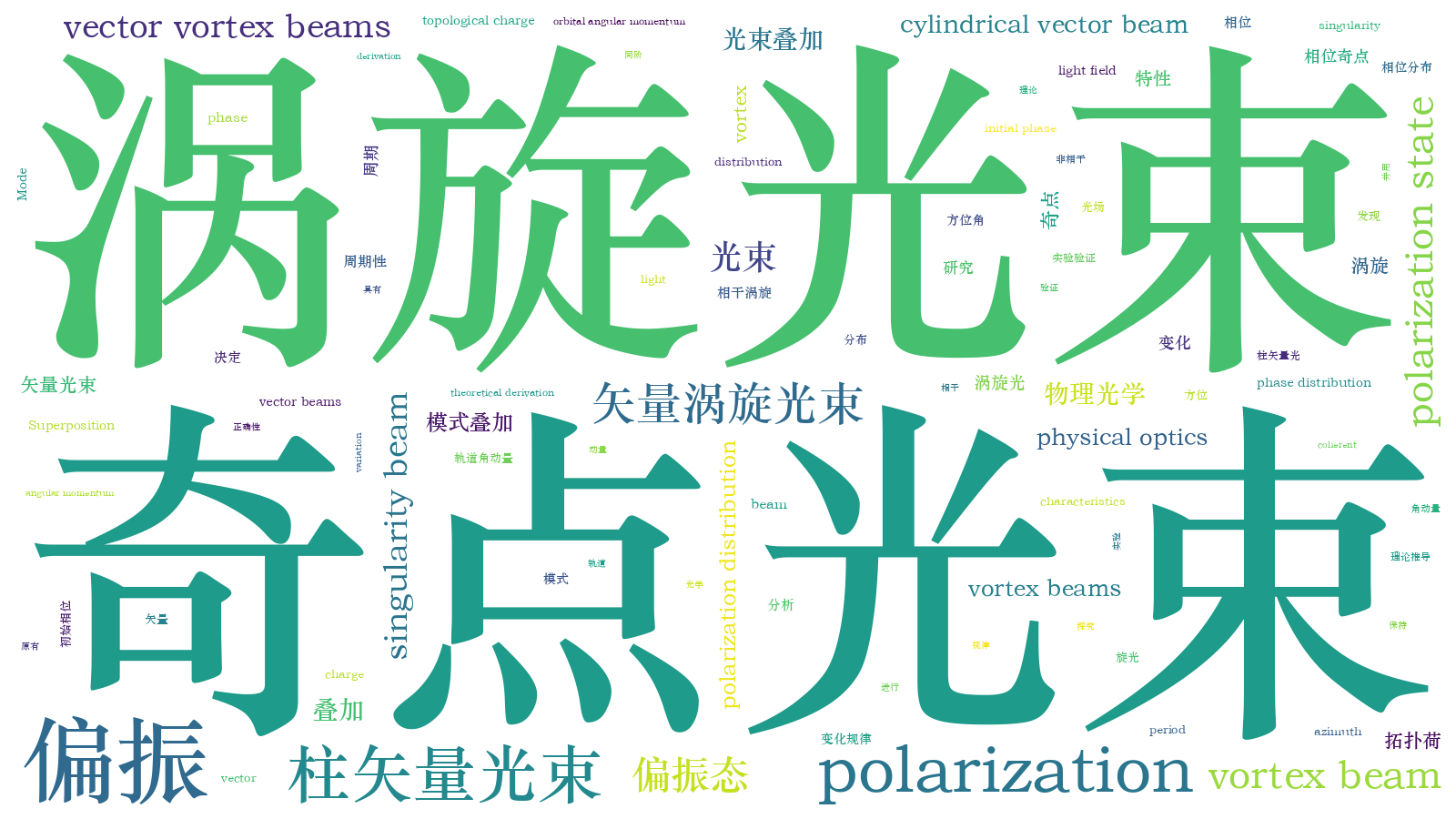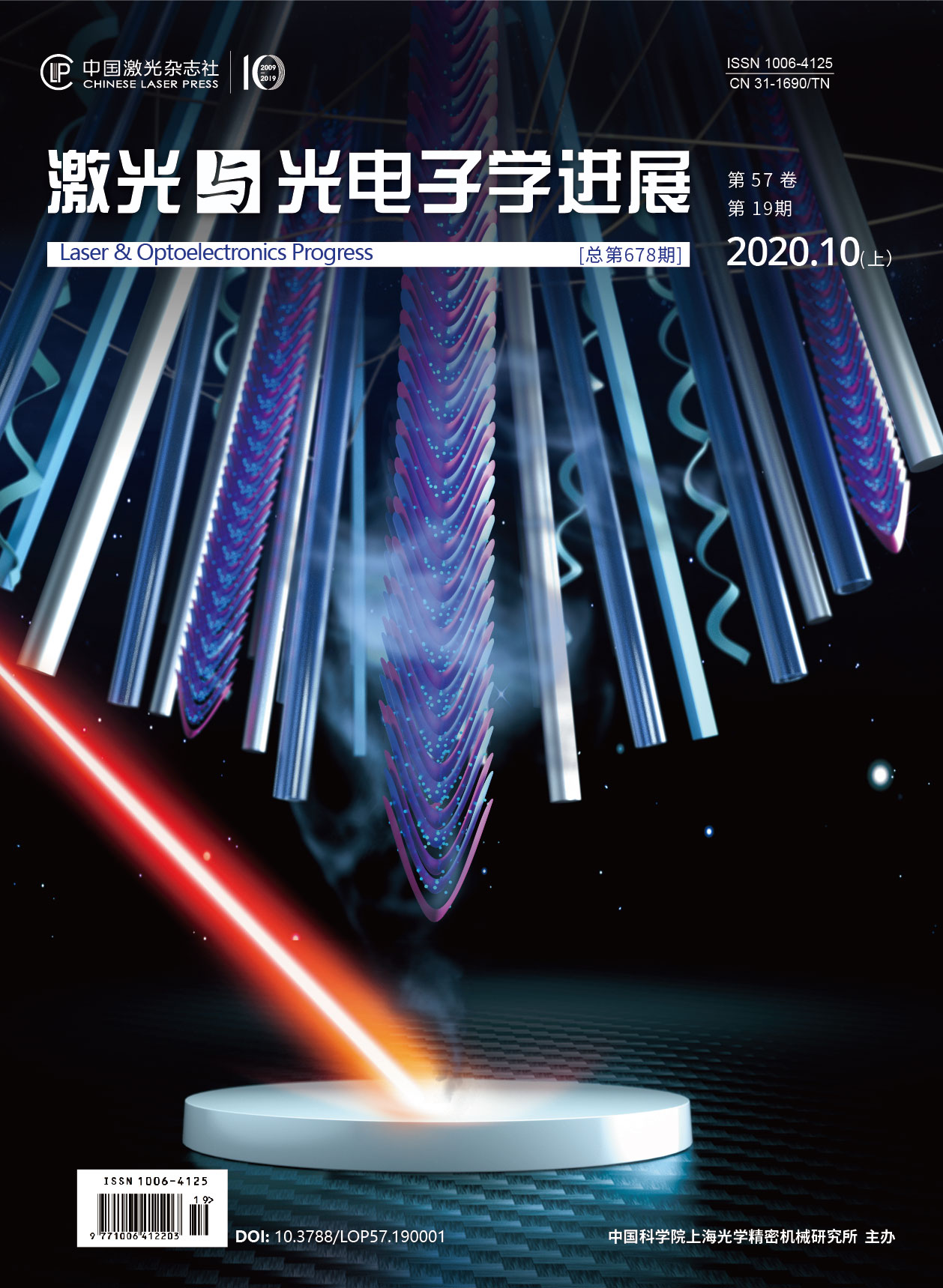奇点光束模式叠加特性研究  下载: 974次
下载: 974次
1 引言
奇点光束[1]作为近些年来热门的研究对象,有诸方面的应用。奇点光束包括涡旋光束[2]和柱矢量光束(CVB)[3]。涡旋光束具有特殊的螺旋波前结构和环形强度分布,可以作为光镊的光源,从而实现微观粒子的囚禁和捕获[4-5],在量子信息处理[6]、数据存储[7]等方面具有广泛的应用。CVB具有轴对称偏振分布特性,能量呈轴对称分布,在紧聚焦情况下具有独特的聚焦特性,在激光加工[8]、粒子捕获[9-10]、表面等离子加工等方面具有非常大的应用价值。在通信方面,相对于传统的复用技术,奇点光束的复用具有正交性、安全性等优点,在提升通信容量方面受到越来越多的关注。2013年,Bozinovic等[11]报道了拓扑荷值(TC)为±1的双通道轨道角动量(OAM)态的传输;2015年,Milione等[12]报道了自由空间中四通道的CVB的复用与解复用;2017年,Qiao等[13]实现了光纤中拓扑荷值绝对值相等的四束CVB的复用与解复用实验。奇点光束相互叠加时,产生的光束和原来的单一状态的光束有很大不同,叠加后复合光场的光场分布和奇异性等都发生了规律性变化,产生具有丰富偏振态和相位分布的庞加莱光束[14-17],这使人们能够进一步研究奇点光束在数据存储、光电子学、信息处理及微观粒子俘获等方面的潜力。
本文首先介绍了奇点光束的基本性质,之后从理论上对同阶非相干涡旋光束、同阶相干涡旋光束、不同偏振拓扑荷值的CVB、柱矢量涡旋光束叠加后光场的相位分布、偏振分布进行分析,并用实验证实了理论推导的正确性。研究结果给奇点光束在光通信、信息处理、光学操控等方面的应用提供了一定的参考意义。
2 奇点光束的概念
2.1 涡旋光束
涡旋光束的相位分布函数中含有与方位角呈正比的项exp(ilφ),沿z轴传播的涡旋光束的电场可表示为
式中:l为涡旋光束的拓扑荷值,也叫涡旋光束的角量子数,理论上可以取任意整数(当l=0时,光束即为高斯光束);φ为方位角。当极径r=0时,方位角φ没有确定值,中心处的相位值也无法确定,因此中心形成相位奇点。常见的涡旋光束有拉盖尔-高斯光束[18]、高阶贝塞尔光束[19]等,本文主要以拉盖尔-高斯型的涡旋光束为例。
2.2 柱矢量光束
柱矢量光束横截面的偏振呈轴对称分布,是麦克斯韦方程组的解,任意阶柱矢量光束的琼斯矩阵[20]可以写为
式中:m为柱矢量光束的偏振拓扑荷值;ϕ0为初始偏振角。由(2)式可知,柱矢量光束包含两个旋转方向相反的圆偏振涡旋光束,可以表示为两个自旋本征态的叠加。
3 涡旋光束的非相干叠加
拉盖尔-高斯光束是常见的涡旋光束。拉盖尔-高斯光束的振幅分布[21]可表示为
式中:k0为波数;zR为瑞利距离;(2p+
实验结果如

图 1. 涡旋光束非相干叠加后光场理论偏振分布和实验检偏图像。(a1)水平偏振;(a2)竖直偏振;(a3)合束光斑;(b1)实验合束光斑;(b2) 45°检偏;(b3)圆检偏
Fig. 1. Theoretical polarization distributions of light field and experimental bias images after incoherent superposition of vortex beams. (a1) Horizontally polarization; (a2) vertically polarization; (a3) combined beam spot; (b1) experimental combined beam spot; (b2) polarization state at 45°; (b3) circle polarization state
4 柱矢量光束的叠加
CVB是近年来光通信研究领域的热点之一,CVB具有轴对称偏振分布特性,能量呈轴对称分布,在传输模式和稳定性方面具有一定的优势。CVB可以用琼斯矢量表示为
式中:A(r,z)为光束的振幅分布;φ0为φ=0处电场矢量与x轴的夹角。
两束具有不同m、φ0的CVB合束,其光场的偏振和奇异性发生了变化。CVB叠加后是平面波,为了直观地表示CVB合束后的偏振分布,给出单束CVB和合束CVB的偏振分布,如
以

图 2. 柱矢量光束叠加后的光场理论偏振分布及实验检偏图像。(a) CVB1;(b) CVB2;(c)理论合束光斑;(d)实验合束光斑;(e) 0°检偏;(f) 45°检偏
Fig. 2. Theoretical polarization distributions of light field and experimental bias images after superposition of cylindrical vector beams. (a) CVB1; (b) CVB2; (c) theoretical combined beam spot; (d) experimental combined beam spot; (e) polarization state at 0°; (f) polarization state at 45°
5 柱矢量涡旋光束的叠加
同时具有偏振涡旋和相位涡旋的光束称为矢量涡旋光束[23]。矢量涡旋光束是涡旋光束和柱矢量光束的一种普遍形式,既具有横截面各向异性的偏振态分布,又具有螺旋相位,并携带有轨道角动量[24]。涡旋光束和柱矢量光束可以分别看作是一种特殊的矢量涡旋光束。
涡旋光束与柱矢量光束叠加产生的具有涡旋特性和偏振特性的柱矢量涡旋光束可以表示为
当两束矢量涡旋光束叠加时,会有多种偏振态同时存在的庞加莱光束,由于同样携带相反的涡旋拓扑荷值,叠加后的光束为平面波。以涡旋拓扑荷值l1=2,偏振拓扑荷值m1=1、φ0=0的柱矢量涡旋光与涡旋拓扑荷值l2=-2,偏振拓扑荷值m2=1、φ0=π/2的柱矢量涡旋光叠加为例,如

图 3. 矢量涡旋光束叠加后的光场理论偏振分布及实验检偏图像。(a1) l1=2,m1=1,φ0=0;(a2) l2=-2,m2=1,φ0=π/2;(a3)合束光斑;(b1)实验合束光斑;(b2)45°检偏;(b3)圆检偏
Fig. 3. Theoretical polarization distribution of light field and experimental bias images after superposition of vector vortex beams. (a1) l1=2, m1=1, φ0=0; (a2) l2=-2, m2=1, φ0=π/2; (a3) combined beam spot; (b1) experimental combined beam spot; (b2) polarization state at 45 °; (b3) circle polarization state
输入两束光的相位差为Δφ=(l1-l2)φ=2l1φ。合束后光束的偏振态会随方位角φ的变化而变化,当Δφ=0,π时为线偏振,当Δφ=π/2时为圆偏振,当Δφ等于其他值时为椭圆偏振。改变涡旋拓扑荷值l会改变圆偏振的位置,改变偏振拓扑荷值m会改变线偏振的方向。φ=0时,相位差为0,合偏振为45°线偏振;φ=π/8时,相位差为π/2,合偏振为左旋圆偏振;φ=π/4时,相位差为π,合偏振为水平线偏振;φ=3π/8时,相位差为3π/2,合偏振为右旋圆偏振;当φ为其他值时,合偏振为椭圆偏振。
实验检偏结果如
6 结论
从奇点光束的概念出发,首先介绍了基于相位奇点的涡旋光束和基于偏振奇点的柱矢量光束,其中柱矢量光束又可以分解为两个阶数相同、拓扑荷值符号相反的涡旋光束。重点介绍了双束非相干涡旋光叠加后的光场分布和偏振分布;介绍了两束柱矢量光束叠加后其偏振态的变化;最后介绍了两束具有涡旋特性和偏振特性柱矢量涡旋光叠加产生的庞加莱光束。通过对奇点光束叠加特性的研究可以看出,奇点光束在自由空间光通信和光纤通信中可以提高通信容量。奇点光束复用光通信技术在短距离和大容量光通信领域有重要的应用意义,例如在数据中心和高性能计算机内部替换现有的单信道通信技术,可提高光通信容量密度,减少光纤数目。奇点光束叠加的研究加深了对光的物理特性理解,期待奇点光束复用光通信技术能在未来实现革命性的应用。
[1] Dennis M R. O'Holleran K, Padgett M J. Singular optics: optical vortices and polarization singularities[J]. Progress in Optics, 2009, 53: 293-363.
[4] He H. Friese M E J, Heckenberg N R, et al. Direct observation of transfer of angular momentum to absorptive particles from a laser beam with a phase singularity[J]. Physical Review Letters, 1995, 75(5): 826-829.
[5] Cisowski C M. Correia R R B. Splitting an optical vortex beam to study photonic orbit-orbit interactions[J]. Optics Letters, 2018, 43(3): 499-502.
[6] Mair A, Vaziri A, Weihs G, et al. Entanglement of the orbital angular momentum states of photons[J]. Nature, 2001, 412(6844): 313-316.
[7] Voogd RJ, SinghM, Pereira SF, et al. The use of orbital angular momentum of light beams for super-high density optical data storage[C]∥Frontiers in Optics 2004/Laser Science XXII/Diffractive Optics and Micro-Optics/Optical Fabrication and Testing, October 12-14, 2004, Rochester, USA. Washington, DC: OSA, 2004: FTuG14.
[9] Lin J, Zheng W, Wang H F, et al. Effects of scatterers' sizes on near-field coherent anti-Stokes Raman scattering under tightly focused radially and linearly polarized light excitation[J]. Optics Express, 2010, 18(10): 10888-10895.
[10] Tian B, Pu J X. Tight focusing of a double-ring-shaped, azimuthally polarized beam[J]. Optics Letters, 2011, 36(11): 2014-2016.
[12] Milione G. Lavery M P J, Huang H, et al. 4×20 Gbit/s mode division multiplexing over free space using vector modes and a q-plate mode (de)multiplexer[J]. Optics Letters, 2015, 40(9): 1980-1983.
[13] Qiao W, Lei T, Wu Z T, et al. Approach to multiplexing fiber communication with cylindrical vector beams[J]. Optics Letters, 2017, 42(13): 2579-2582.
[16] Yi X N, Liu Y C, Ling X H, et al. Hybrid-order Poincaré sphere[J]. Physical Review A, 2015, 91(2): 023801.
[17] Naidoo D, Roux F S, Dudley A, et al. Controlled generation of higher-order Poincaré sphere beams from a laser[J]. Nature Photonics, 2016, 10(5): 327-332.
[18] Arlt J, Dholakia K, Allen L, et al. The production of multiringed Laguerre-Gaussian modes by computer-generated holograms[J]. Journal of Modern Optics, 1998, 45(6): 1231-1237.
[19] Gori F, Guattari G, Padovani C. Bessel-Gauss beams[J]. Optics Communications, 1987, 64(6): 491-495.
[20] Moh K J, Yuan X C, Bu J, et al. Generating radial or azimuthal polarization by axial sampling of circularly polarized vortex beams[J]. Applied Optics, 2007, 46(30): 7544-7551.
[21] AllenL, Padgett MJ, BabikerM. IV the orbital angular momentum of light[M] ∥Wolf E. Progress in optics. Amsterdam: Elsevier, 1999, ( 39): 291- 372.
[23] Zhang D K, Feng X, Cui K Y, et al. Identifying orbital angular momentum of vectorial vortices with Pancharatnam phase and Stokes parameters[J]. Scientific Reports, 2015, 5: 11982.
[24] Milione G, Evans S, Nolan D A, et al. Higher order Pancharatnam-Berry phase and the angular momentum of light[J]. Physical Review Letters, 2012, 108(19): 190401.
黄慧, 寿倩, 陈志超. 奇点光束模式叠加特性研究[J]. 激光与光电子学进展, 2020, 57(19): 192601. Hui Huang, Qian Shou, Zhichao Chen. Research on Superposition Characteristics of Singularity Beam Mode[J]. Laser & Optoelectronics Progress, 2020, 57(19): 192601.






